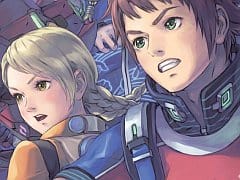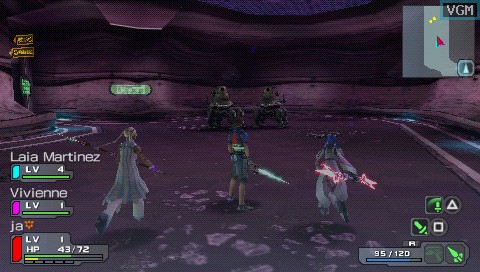You can trust VideoGamer. Our team of gaming experts spend hours testing and reviewing the latest games, to ensure you're reading the most comprehensive guide possible. Rest assured, all imagery and advice is unique and original. Check out how we test and review games here
Phantasy Star is, I imagine, a video game brand many are aware of but haven’t actually played. While there are surely many fans of the series floating about the Internet, the ten-year-old Dreamcast iteration, with its “from the future” online play, never clawed its way into the video game mainstream. My own memory of that game is watching a friend sit in front of his television, eyes squinting in concentration as his anime sci-fi character hacked its way through endless hordes of monsters with other human players! With this latest venture on PSP, the cleverly named Phantasy Star Portable, you almost feel as if SEGA has taken a backwards step with the series, but fans may well think it reason enough to fork out for one of Sony’s flash handhelds.
The premise is this: create a character from an excellent number of options, including gender, race and class, then embark on a series of missions on various and varied planets with AI-controlled party members or, via local wireless, three other real-life players. The action’s classic PSP third-person fare, with movement and camera mapped to the analogue nub and attacks governed by the face buttons. At its most basic, you run around a linear map killing every enemy that spawns until you reach a boss. Then, in classic RPG style, it’s level up and grab the loot time.
In reality, because there’s no online option (hence the backwards step comment) it’ll be a rare occasion indeed when you come into contact with three friends who are not only PSP owners but Phantasy Star fans as well. So rare, in fact, that we were unable to test the multiplayer function. This will leave most players with only the Story mode to fuss over. Here, your created character, which is playable across both modes, begins as a newly graduated member of the intergalactic peacekeeping organisation, the GUARDIANS. The action takes place some time after the events of the last Phantasy Star game, 2006’s Universe. A terrorist, who you meet early on, tinkers with the robots on the GUARDIAN space station, causing them to go nuts. With your new CAST partner (humanoid robots with emotions) it’s up to you to clear the robots out, track down the terrorist and stop the once-thought defeated SEED.
It’s schoolboy sci-fi shenanigans, of course, and at times the plot and dialogue are laughably bad. Long stretches of painstakingly wooden dialogue play over still images of the game’s poorly-designed cast (heh). All the female characters in the game, be they CAST or Humans, sound like annoying schoolgirls. There’s an awfully-voiced cad character who can’t help but ask everything with tits out on a date, and an old CAST professor type whose perversions aren’t funny in the slightest. There aren’t any surprises and the central theme – can robots love? – isn’t dealt with using any real intelligence. Indeed the incessant schoolgirl pondering of your CAST partner, Vivienne, grates after little more than half an hour. Yes, Phantasy Star Portable is very Japanese indeed.
Which isn’t really the point, to be honest, since the focus here is on levelling up, customisation and soldiering through the many missions on offer at the Mission Counter. The 3D hubs of previous Phantasy Star games have been dumped here in favour of a 2D top down perspective, and navigation between different sections, as well as NPC chat, involves nothing more than pressing left and right on the d-pad to move between icons. Some fans will obviously be disappointed with this stripped down approach – indeed you can’t help but feel as if the game is something of a lazy effort when it comes to production values – but I wasn’t too bothered by it. In fact, I felt as if browsing through selectable icons was a much quicker way of navigating the game’s central hubs, and a much better fit on the PSP, with its focus on short bursts of play.
Special Missions will occasionally present themselves, allowing you to forward the story. The side quests are designed for levelling, the grind, and for you to improve the statistics and equipment of your character. If ever there was a game that preyed on those with even the slightest aversion to loot hunting, it’s this one.
It’s out on the battlefield where Phantasy Star has always shone, and it’s no different here. You have a basic strike with your primary weapon and a secondary fire, perhaps a shot from a one handed gun, for example (there’s a first-person mode for more accurate gun fire). You’re able to quickly access items, for healing mainly, by pressing and holding the Circle button and bringing up the Action Palette. From there, scrolling down a menu then releasing the button will use the item you’ve highlighted. You’re able to quickly switch between weapons in the same way, from dual wielding, for example, to a two-handed spear. It’s all done in real-time, though, so there’s no pausing, not even to see the map.
The combat itself is strangely therapeutic. You find yourself slipping into “the zone” as you begin to robotically nail the timing-based combos and, as a result, enjoy the big damage numbers that float above defeated monsters. Most missions follow the same format – kill all enemies in sight until a key drops, which you use to unlock the next area. Rinse and repeat till you find the boss, a big dragon maybe, or a hideous plant. It can feel very repetitive, especially when you’re knee-deep in the grind. The missions get more difficult the further you get into the game, as you’d expect, with more, and tougher, enemies thrown at you, but you never feel as if it’s the enemies that cause you the most problems. No, that dubious honour goes to the AI.
Your AI-controlled party members seem to have a real problem working out how to get from A to B – yes, it’s that old pathfinding problem rearing its ugly head again. When they are by your side, what they do feels at best completely random and at worst wholly inappropriate. You never get a heal when you need one and you never get an off tank when you’ve got a few monsters smacking your face. MMO-players will know what I mean when I say playing the Story mode often feels like you’re running a dungeon with a pick-up group. A drunk pick-up group at that.
Still, because of how addictive the pursuit of experience points and shiny loot can be, Phantasy Star drags you through its virtual innards whether you like it or not. At the end of a mission you’ll score points for the number of defeated creatures and the number of party incapacitations, as well as an overall rank. Most missions are repeatable on higher difficulties, which is how you’ll get the good stuff. There’s an astonishing number of weapons available, from shotguns to laser swords to spears. Nabbing that one piece of equipment that you know will make you stand out on the off chance that you’ll ever form a party with other real-life players proves a surprisingly compelling motivation. For me, the game rekindles memories of Silicon Knights’ ultimately disappointing dungeon-crawler Too Human – both games are good and bad for the same reasons.
While some Phantasy Star fans will lament the stripped down nature of the game – from SEGA’s point of view, this was unavoidable – overall it’s complete fan service. The lack of online play (something that may be rectified by the PSP’s linking with the PS3) is a disappointment, as is the overall sense that it’s not quite as triple-A a product as it could have been, but as a PSP game it’s certainly up there with the best of 2009. Like the Dreamcast classic, it won’t drag the series into the mainstream, but perhaps that’s too much to ask. Phantasy Star might always be just one of those games you’ve heard of but never played.

/https://oimg.videogamer.com/images/dc8d/phantasy_star_portable_32.jpg)
/https://oimg.videogamer.com/images/d790/phantasy_star_portable_57.jpg)






